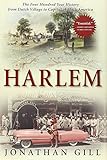Harlem : the four hundred year history from Dutch village to capital of Black America / Jonathan Gill.
Material type: TextPublication details: New York : Grove Press ; Berkeley, Calif. : Distributed by Publishers Group West, 2011.Description: 520 p., [32] p. of plates : ill., maps ; 24 cmISBN:
TextPublication details: New York : Grove Press ; Berkeley, Calif. : Distributed by Publishers Group West, 2011.Description: 520 p., [32] p. of plates : ill., maps ; 24 cmISBN: - 9780802119100
- 0802119107
- 974.71
- 002 F 128.68 G475h 2011
| Item type | Current library | Home library | Collection | Shelving location | Call number | Vol info | Copy number | Status | Barcode | |
|---|---|---|---|---|---|---|---|---|---|---|
 Libro
Libro
|
Biblioteca Juan Bosch | Biblioteca Juan Bosch | Recursos Regionales | Recursos Regionales (2do. Piso) | 002 F 128.68 G475h 2011 (Browse shelf(Opens below)) | 1 | 1 | Available | 00000108429 |
Includes bibliographical references (p. [469]-479) and index.
Harlem is perhaps the most famous, iconic neighborhood in the United States. A bastion of freedom and the capital of Black America, Harlem's twentieth century renaissance changed our arts, culture, and politics forever. But this is only one of the many chapters in its history. In this work the author, a historian presents a chronicle of this remarkable place. From Henry Hudson's first contact with native Harlemites, through Harlem's years as a colonial outpost on the edge of the known world, he traces the neighborhood's story, marshaling a wealth of detail and a host of figures from George Washington to Langston Hughes. Harlem was an agricultural center under British rule and the site of a key early battle in the Revolutionary War. Later, wealthy elites including Alexander Hamilton built great estates there for entertainment and respite from the epidemics ravaging downtown. In the nineteenth century, transportation urbanized Harlem and brought waves of immigrants from Germany, Italy, Ireland, and elsewhere. Harlem's mix of cultures, extraordinary wealth and extreme poverty was electrifying and explosive. This work is the history of the Manhattan neighborhood of Harlem, beginning with Hudson's first experiences in the area, through its early growth as a Dutch village and colonial agricultural center, to its transformation into a modern neighborhood.
Unrighteous beginnings: from Muscoota to Nieuw Haarlem, 1609-1664 -- Strange bedfellows: British Harlem, 1664-1781 -- Sweet asylum: founding an American Harlem, 1781-1811 -- The future is uptown, 1811-1863 -- The flash age, 1863-1898 -- Nostra Harlem, undzere Harlem: the age of immigration -- "To race with the world": the new Negro and the Harlem Renaissance -- "The kingdom of culture": Harlem's Renaissance comes of age -- "Moon over Harlem": the Great Depression uptown, 1929-1943 -- "Tempus fugue-it": Harlem in the Civil Rights Era, 1943-1965 -- Harlem nightmare, 1965-1990 -- Old and new dreams: reviving the Renaissance.
There are no comments on this title.

